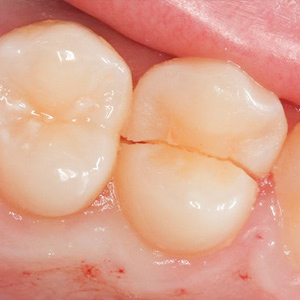Teeth can take a lot of force over a lifetime of biting and chewing, thanks to enamel, their outer layer made of the strongest substance in the human body. Unfortunately, they’re not invincible: it’s even possible for you to break or “fracture” a tooth while biting or chewing normally.Although such a fracture might seem to occur out of the blue, it’s usually related to a condition known as cracked tooth syndrome. It usually occurs in three stages: in the first, miniscule cracks in the outer enamel known as craze lines develop. They’re not immediately dangerous since they only involve the enamel surface; but left untreated they could deepen and progress to the next stage, a larger crack that penetrates the tooth’s underlying dentin.If allowed to grow, this crack in turn can lead to the third stage, a full fracture that could extend down to the root. A fracture can put the tooth in danger of loss, especially if its inner pulp becomes exposed. To avoid this worst case, it’s best to treat the tooth at the earliest stage possible when craze lines are just developing.There is a difficulty, though, with detecting craze lines — they’re small, too small to detect normally with x-rays. We, therefore, rely on other methods such as using an instrument called an explorer to feel for cracks, having the patient bite on a stick or rubber pad to replicate pain symptoms or using fiber-optic lighting with special dye stains to highlight possible cracks. Endodontists, specialists in root canals, can use microscopic equipment that’s quite adept at detecting craze lines.There are also some signs you can be on alert for that might indicate a craze line or crack. If you feel a short, sharp pain — a “wince” — when chewing and releasing food, you could have a crack that hasn’t yet affected the nerves. If a true fracture occurs, the pain will intensify and you may notice pieces of the tooth coming off. If the crack extends to the root, the pain will become greater and more chronic.It’s important then that you see us for any recurring pain symptoms as soon as possible. If it’s a crack, the sooner it’s treated the better your tooth’s chances for survival.If you would like more information on cracked tooth syndrome, please contact us or schedule an appointment for a consultation. You can also learn more about this topic by reading the Dear Doctor magazine article “Cracked Tooth Syndrome.”
Recent Posts
- The Importance of Emergency Dental Care: Timely Intervention is Key
- Delaying Wisdom Teeth Extraction Can Lead to Serious Issues
- Can an Abscessed Tooth Kill You? Symptoms and When to Seek Urgent Care
- How to Recognize and Effectively Treat a Dental Emergency
- Gum Disease and Heart Disease: Understanding the Connection

